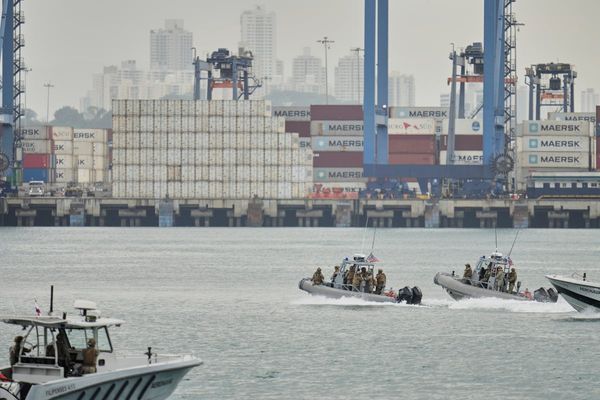A Russian fighter has collided with a US Reaper drone, forcing it down into the Black Sea, in what US forces called an “unsafe and unprofessional” intercept.
A US European Command statement said the collision happened just after 7am on Tuesday morning, when two Russian Su-27 fighter jets flew up to the MQ-9 Reaper drone over international waters west of Crimea. The statement said the Russian pilots sought to disrupt the US aircraft before the collision.
“Several times before the collision, the Su-27s dumped fuel on and flew in front of the MQ-9 in a reckless, environmentally unsound and unprofessional manner,” the US statement said. “This incident demonstrates a lack of competence in addition to being unsafe and unprofessional.”
One of the Russian fighters then struck the drone’s propeller, “causing US forces to have to bring the MQ-9 down in international waters”.
The Pentagon spokesman, Brig Gen Patrick Ryder, said the Russian planes were in close proximity to the drone for about half an hour, and that the Su-27 which struck it was probably damaged.
“It essentially ran into the MQ-9,” Ryder said. It is believed the Russian Su-27 landed at an airbase in occupied Crimea.
Russia’s defence ministry denied there was any collision and suggested the drone was brought down through pilot mishandling.
The downing of the $32m drone triggered a race to recover the wreckage, as it contains some of the most advanced US technology and would be an intelligence windfall for Russia if it got to the aircraft first.
“To my knowledge, at this point in time, the Russians have not recovered that aircraft,” Gen Ryder said on Tuesday afternoon.
The European Command statement warned: “These aggressive actions by Russian aircrew are dangerous and could lead to miscalculation and unintended escalation.”
“Our MQ-9 aircraft was conducting routine operations in international airspace when it was intercepted and hit by a Russian aircraft, resulting in a crash and complete loss of the MQ-9,” Gen James Hecker, the US air force commander for Europe and Africa, said. “In fact, this unsafe and unprofessional act by the Russians nearly caused both aircraft to crash.”
Russia’s defence ministry said in a statement that its fighters “did not use airborne weapons and did not come into contact” with the US drone.
The ministry said that fighters from its air defence forces were scrambled to identify the drone which the ministry claimed was heading “in direction of the state border of the Russian Federation”.
“As a result of sharp manoeuvring around 9.30 (Moscow time), the MQ-9 unmanned aerial vehicle went into uncontrolled flight with a loss of altitude and collided with the water surface,” the ministry said, adding that its fighter jets returned safely to their base.
It is the first collision between Russian and Nato aircraft since Russia’s full-scale invasion just over a year ago, but it has highlighted the dangers of a clash leading to escalation through mistake or miscalculation as Russia and Nato forces field increasing amounts of military hardware around Ukraine – risks heightened by reckless behaviour.
“This is my biggest worry, both there and in the Pacific, that an aggressive Russian or Chinese pilot or vessel captain gets too close, doesn’t realize where they are and causes a collision,” the head of the US Marine Corps, Gen David Berger, said.
The European Command statement said that the incident was part of a “pattern of dangerous actions by Russian pilots while interacting with US and allied aircraft over international airspace, including over the Black Sea”.
In the White House on Tuesday, the national security council spokesman, John Kirby, said: “It is not the first time certainly in recent weeks there’s been intercepts.”
But Kirby added: “It is the first time that an intercept resulted in the ‘splashing’ of one of our drones.”
He said that Joe Biden had been briefed on the incident, and the state department spokesman, Ned Price, said the US had summoned the Russian ambassador Anatoly Antonov to “convey our strong objections”.
He stressed the US drone had been operating over international waters, and that the collision would not deter US forces from patrolling the Black Sea.
“US will continue to operate in international airspace over international waters,” Kirby said. “The Black Sea belongs to no one.”
Later, Antonov said Moscow views the incident as “a provocation” but said Moscow does not want confrontation with the US.
Speaking during a visit to Japan, Ben Wallace, the British defence secretary, urged Moscow to respect international airspace.
Dara Massicot, a senior policy researcher at the Rand Corporation, said that the incident was just the latest in a long series of episodes over many years of what she called “coercive signalling” by Russian forces. This was the first time she was aware of a Russian jet dumping fuel on a Nato aircraft, but she said it “fits with a larger pattern of escalating signals before coming too close to a platform”.
“In this case, the SU-27 pilot is said to have hit the propeller, damaging the MQ-9 –probably a pass, intended to compel it to change course – that came too close,” Massicot said on Twitter.
Mary Ellen O’Connell, a Notre Dame Law School professor and expert on international law and the use of force, noted that by dumping fuel and downing the drone, the Russian pilot was “further polluting the fragile Black Sea”, but she noted the US had not called the interception “unlawful”.
“In all likelihood the Reaper was conducting surveillance for Ukraine. Under the laws of armed conflict Russia may disrupt such assistance,” O’Connell said.







